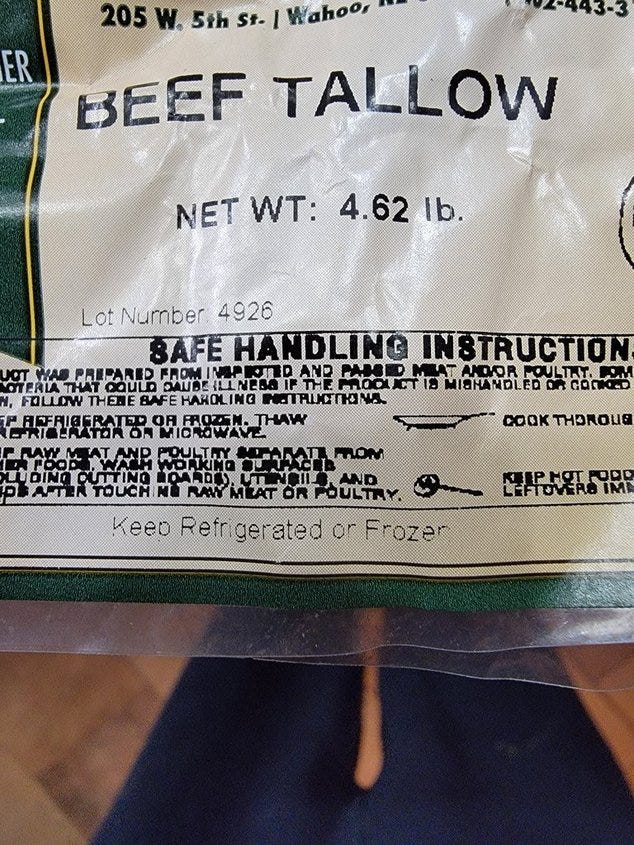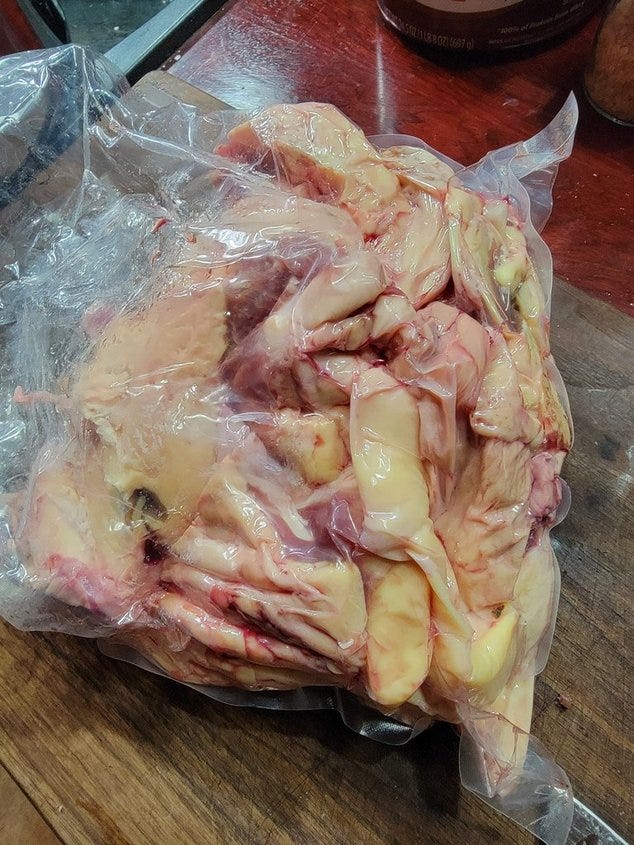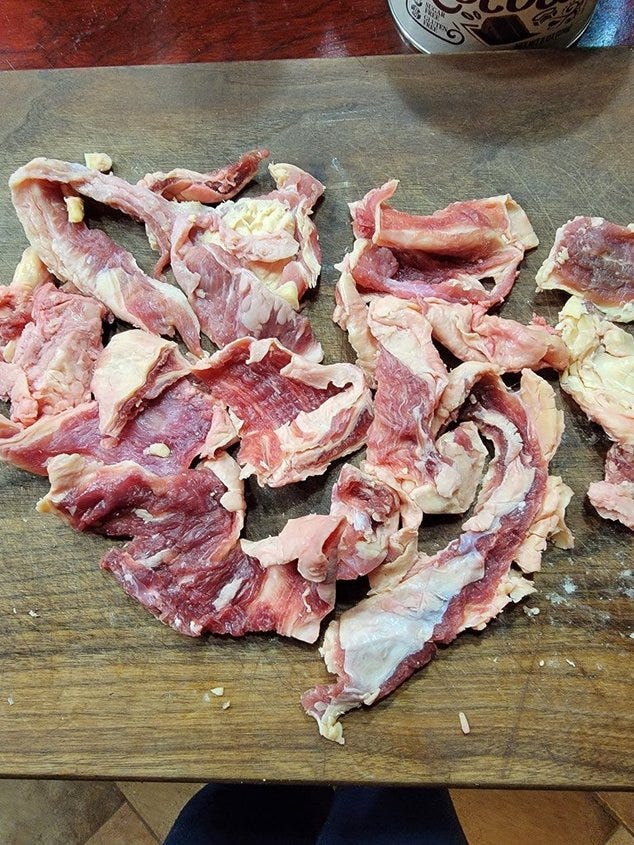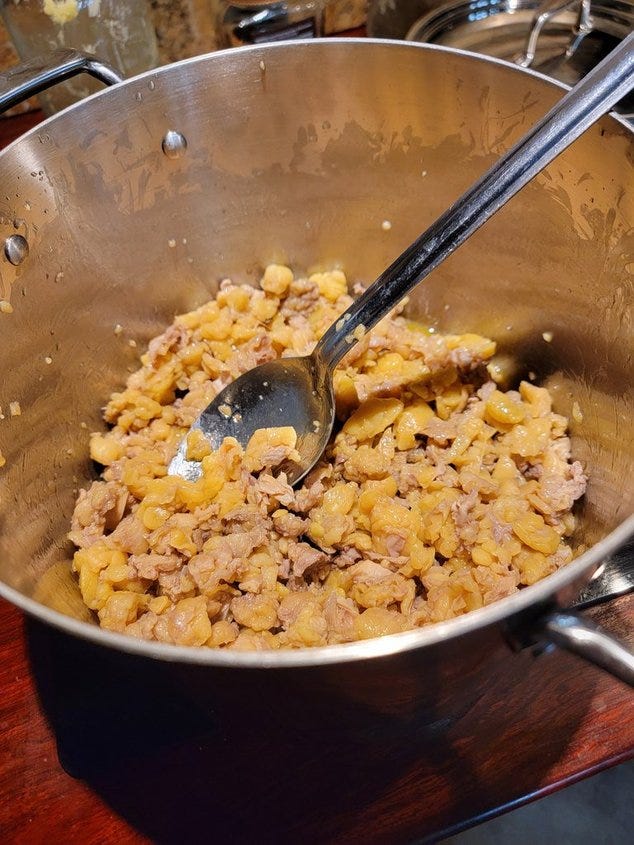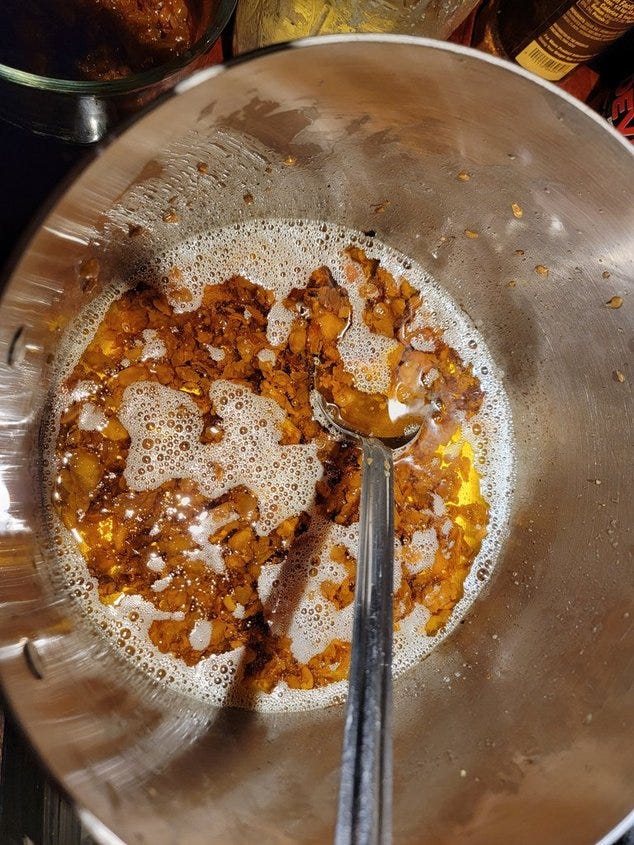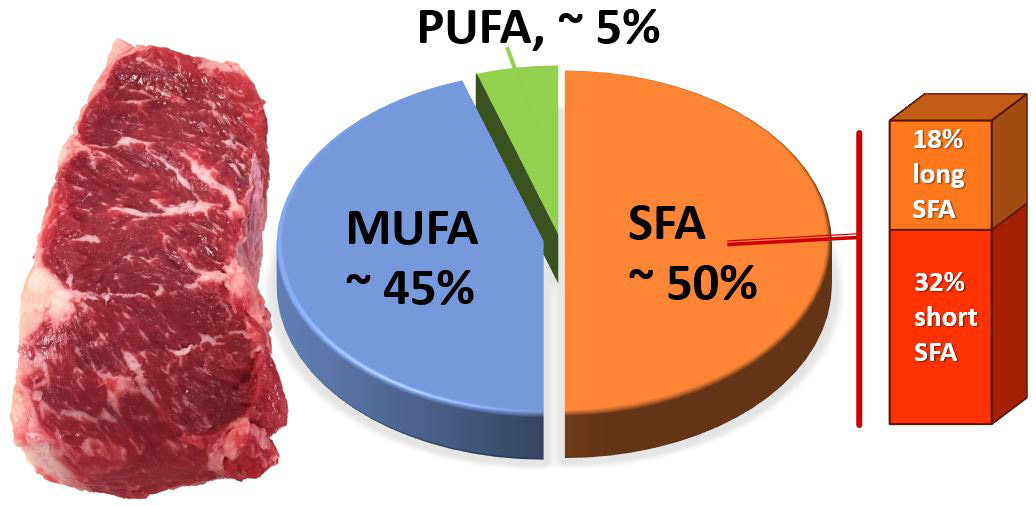Something that many of our grandmothers did is make beef tallow or pork lard. I remember “helping” my grandmother do this as a young lad. (I was fortunate as at 4 years old my grandparents moved fromt he farm to the city so they both brang their farm life with them where they could. By the time my siblings were old enough to remember they had mostly gravitated to the “easier” city life. They really missed out of many things….)It is something I have recently started doing also as I have thrown out all the seed oils and have moved to healthier oils. Beef tallow and lard are two animal fats that are readily available at your local butcher shop. Duck and chicken fat can also be rendered, but they are hard to find unless you raise your own.
Start with a few pounds of fat. Grass fed is prefered but I grai finish my cattle so its what I have. This particular fat is from a 10 year old cow that was fed corn for 60 days. Likely this being a old cow her fat would be yellow due to her age more so than 60 days of corn. Grass-finished beef has yellow fat that is soft, pliable and easy to cut. The yellow coloring is from the carotenes in the grasses on which the animal was finished.
As a side note, no old cows do not just make hamburger, I had this one made into steaks, rib roasts, chuck steaks and roasts and hamburger. No it is not tough, it has a somewhat differnt texture - its solid not mushy or tough. It has a richer beefier flavor profile.
You can have the fat ground or just in chunks. I have not used ground for several reasons. I am going to be more particular in cutting out the meat and glans that a butcher.
You want to in addition to cutting away as much meat as you can remove and gland material.
any pot will do
This is the cut out that is not used in the rendering process. You can salt it and cook it like bacon if you wish.
Start of the rendering process, I have used stove top and oven. Both work well. Around 200-230 degrees for about 4 hours stirring every 30 minutes or so. Stove top is probably more energy efficient but that’s a fleeting concern. Do what fits your needs. You can also use a slow cooker instead of a stock pot. It’s very easy to burn the fat in a pot on the stove top, which I came close to doing. Using a slow cooker set to LOW keeps the fat at low, steady simmer. No lids! you want the moisture to flash off.
Near the end of the process. the fat has shrunk as the fat has been separated by the heating.
Spoon out as much of the particles as you can. I have found the slotted collander/sloted skimmer spoon I use to make cheese works great for this.
A quart mason jar, a funnel and cheese cloth. I sterilize the jar for 15 minutes in a 200 degree oven.
The bits strained out of the tallow.
Drop a lid on it, I use new caning lids, as the liquid cools it will suck down onto the seal and seal the jar.
Let it cool, in a few hours it will solidify and you can refrigerate it. Initially the color will be a yellow but it will lighten as it cools. If the color is orange or darker, it means your tallow is overcooked/burnt.
All the stuff left behind after rendering. As you can see their is not much. Slightly more than one cup for that 4.6 lb bag.
Fat-soluble vitamins A, D, K, and E are the most prominent of these nutrients, with each vitamin providing markedly different benefits to the body. For example, most people associate vitamin A with good vision. But this nutrient also helps maintain healthy skin. In addition, vitamin D synthesizes calcium for robust bones, while vitamin K promotes blood clotting. Last but not least is vitamin E, an antioxidant that can help protect cells from damage caused by oxidative stress.
Eating a diet rich in grass-fed beef tallow can help promote fat burning and maintain low blood sugar levels. In addition, the individual fatty acids of beef tallow are linked to improved body composition and more significant weight loss, with many saying their pounds seem to melt away when they switch over to tallow as a fuel source.
Promotes Fat Burning
Eating a diet rich in grass-fed beef tallow can help promote fat burning and maintain low blood sugar levels. In addition, the individual fatty acids of beef tallow are linked to improved body composition and more significant weight loss, with many saying their pounds seem to melt away when they switch over to tallow as a fuel source.
Studies have shown the body can quickly adapt by upregulating fat burning when given a high-fat diet. This adaptation helps ensure that the fat consumed isn't stored but used as an energy source instead.
Eating plenty of grass-fed beef tallow is a great way to kickstart your metabolism into fat-burning mode and enjoy the health benefits that come along with it.
Prevents Oxidative Damage
Eating grass-fed beef tallow has long been a staple in many diets due to its high levels of saturated fats. These fats are highly beneficial in protecting against oxidative damage, promoting longevity, and suppressing colon cancer. While many people might remain skeptical of the health benefits of saturated fats, research is beginning to dispel the myth.
A study conducted by researchers in Europe found that increasing rates of saturated fat intake had an inverse correlation with rates of heart disease, effectively shattering any doubts about its role in regulating cholesterol levels.
This seems to be my experience. I have switched to a mostly carnivore diet, I still have coffee, a beer every night or two with dinner - I make my own as long time subscribers know, so at my age I am going to enjoy life a little bit. At 5’5” 160 -165 lbs and 65 years of bodily abuse of farming, building, motorcycle and car accidents all were ganging up and taking their pound of flesh as the arthritis in my knees and hands was becoming close to unbearable and I was taking NSAIDs twice a day to quell the pain. As one that just does not like being on a schedule especially for meds I decided to take a different tack. I started in mid June 2024, by the end of July most of the pain was gone, by September it was pretty much a distant memory. The hand pain is now gone as is the knee pain. I now run up stairs liek I was 30, skipping one as I go. I did have pie over the holiday, and the pain came back so I am redoubling my efforts to avoid this stuff - but man I love good pies. I also am now down to a healthier 136 lbs. Bmi has gone from 27.5 - overweight to 22.5 - normal. I’d like to loose another 5-10 lbs but that may prove difficult as long as I brew beer and do not kick my chocolate addition.
https://www.openaccessgovernment.org/conundrum-human-health-versus-beef-fat-consumption/42079/
The other class of fat that has been linked to negative effects on health is the saturated fat. Epidemiologists identified statistical associations between a diet high in saturated fat and the incidence of coronary heart disease and colon, prostate and breast cancer. This led to the recommendation: “eat a low-fat, low-cholesterol diet.” Most of us have heard this simple recommendation so often, over the past two decades, that we can recite it in our sleep. Touted as a way to lose weight and prevent cancer and heart disease, it is no wonder much of the entire nation hopped on board. With beef labelled as a food high in saturated fat, per capita consumption of beef declined.
It turned out that this simple message is actually wrong. Detailed research carried out in the last decade shows that the total amount of fat in the diet, whether high or low, is not really linked with diseases. What really matters is the type of fat in the diet. Results from the large and long “Women’s Health Initiative Dietary Modification Trial” showed that eating a low-fat diet for eight years did not prevent heart disease, breast cancer, or colon cancer and did not do much for weight loss, either. What is becoming clearer is that bad fats, meaning trans-fat and some short-length saturated fats, increase the risk for coronary heart disease as well as other diseases, while good fats, meaning mono- and polyunsaturated and longer-length saturated fat, lower this risk. The key to a healthy diet is not to reduce total fat intake but to substitute bad fats for good fats.
Beef fat composition
How is beef fitting into this scenario? Marbling fat is an important meat quality trait in relation to juiciness, aroma and tenderness and is the fat depot of most interest in relation to fatty acid composition and human health. It refers to the white flecks or streaks of adipose tissue between the bundles of muscle fibres and is closely linked to intramuscular fat content.
Beef intramuscular fat (figure 1) consists on average of:
50% saturated fatty acids. However, about 32% is stearic acid or C18:0 – a longer chain saturated fatty acid which does not increase plasma low-density lipoprotein (or bad cholesterol) level;
45% monounsaturated fatty acids and;
5% polyunsaturatedfatty acids (including omega 3, omega 6 and CLA or conjugated linoleic acid).
Beef is also a major dietary sources of conjugated linoleic acid (CLA), which possesses a range of health promoting biological properties (antioxidant, reduces circulating cholesterol, reduces cardiovascular risk, protects against atherosclerosis, anti-carcinogenic, reduces body content of adipose tissue and lipid, enhances the immune system). Beef contributes significantly to man’s intake of the important fatty acids EPA and DHA (omega 3 fatty acids), of which there are few rich sources apart from oily fish.
I have found that using this tallow for cooking beef, to chicken to vegetables results in less oil being absorbed into what you are cooking. Most of the tallow you put in the pan will be in the pan when cooking meats, you do not have to keep adding olive oil or other oils either when sauteing vegetables. The tallow coats but for the most part does not penetrate of disappear into thing air.
Tips to rendering beef fat
Upon purchase either freeze it or refrigerate it as it will spoil inside of a day or two.
While you do not want it frozen you will want it close to frozen, it will cut up far easier than room temperature. This works for cutting meat also.
The finer you chop it the fast it will render.
Do not overcook the tallow or it can develop a burnt flavor.
While tallow can be store at room temperature, it will keep much longer in the fridge and even longer in the freezer.
https://www.westonaprice.org/health-topics/food-features/its-the-beef/#gsc.tab=0
An interesting look at various pros and cons and statements about beef over the decades.
https://bumblebeeapothecary.com/beef-tallow-uses/
A very useful site that has many uses and even recipes for using tallow in daily life.
Beef and beef tallow are wonderful products. From food to waterproofing it works wonders. Without these two products the settlers would have had a much harder time then they already had moving westward. Just think of all the uses they used tallow for, cooking, waterproofing, candles, lubricant, skin care, wood care, shampoo, soap, leather conditioning, cast iron pan seasoning on and on. Once you start using it the possiblities are nearly endless.
https://www.survivalsullivan.com/40-ways-use-tallow-survival/
We do not need to be survivalist, homesteaders or off gridders. Tallow can be used in today’s ultra modern societies also. Skin care is an especially important area. Since our skin is our largest organ it absorbs what ever we put on it and puts it into our blood stream. Avoiding the chemical brew in skin care products is just another way to help make ourselves healthier.
So grab your children, grandchildren and bring back this old way of self reliance and a lost art from the past. It will bring you closer to them, and just like me have a life long memory of being with my grandparents.




